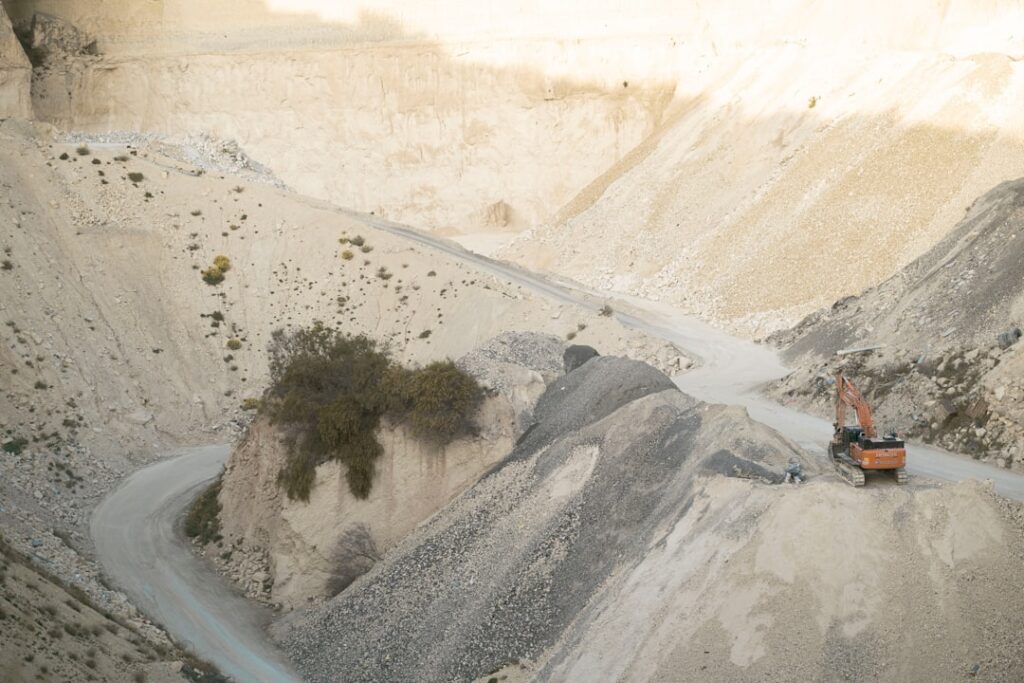When it’s time to pick a stone for your next home project, the choice between travertine and marble can feel overwhelming. Don’t worry, we’ve got you covered.
Both travertine and marble have a rich history in architecture and design, and each stone offers something unique. But how do you decide which one is right for you?
Below, we’ll take a closer look at their key differences and similarities. That way, you’ll have all the info you need to make the best choice.
Formation and Composition

Travertine and marble, two stunning stones, tell unique stories through their formation and composition.
- Travertine is born in the warm embrace of hot springs and deep caves. Over time, minerals gather and harden. This stone breathes with a porous texture, built by heat and pressure into a type of limestone with its own flair.
- Marble, though, takes a different path. It begins as limestone but undergoes a dramatic transformation. Under extreme heat and pressure, it changes into marble in a process known as metamorphism. This metamorphosis reshapes the mineral grains, creating marble’s iconic veined patterns.
Appearance and Aesthetics
Marble catches your eye with its luxurious feel. Its smooth, polished surface and bold veining scream sophistication. One glance and you know: this is elegance at its finest. Walk into a room with marble, and you’re stepping into timeless beauty.
Travertine, though, tells a different story. It’s more rustic, more earthy. When you feel the texture, it’s very natural, almost porous. The look is warm and inviting, like a cozy cottage or a serene outdoor space. Its muted tones blend into the scene, creating a relaxed vibe.
Each stone has its own charm. Marble is about high gloss and grandeur. Travertine? Its matte finish and natural pits offer an organic beauty that’s hard to replicate.
Whether it’s the opulent sheen of marble or the earthy warmth of travertine, both bring something special to any room they grace.
Maintenance and Durability

The durability of marble and travertine hinges on understanding their unique traits. These natural stones breathe, absorbing liquids and stains when not sealed well.
- Marble shines with elegance but is slightly less porous than travertine. Still, it needs regular sealing to keep its flawless appearance. Beware of scratches and etching from acidic spills – maintaining this stone demands diligence.
- Travertine boasts a rustic charm but is even more porous. Without proper protection, it’s vulnerable to stains and wear. Sealing it regularly is key for longevity. Its naturally rough surface attracts dirt, so keeping it clean is crucial for maintaining its appeal.
For both stones, stick to mild soap or specialized cleaners. Harsh chemicals or abrasive tools are a no-go – they can harm the seal and the surface.
Travertine vs Marble: Cost and Value
Choosing between marble and travertine often comes down to weighing their cost and the value they bring to your space.
- Travertine generally costs significantly less per square meter of raw material. That makes it easier on your wallet while still delivering a natural, elegant look.
- Marble? It’s the pricier choice, with costs often reaching hundreds of dollars per square meter, depending on the stone’s quality. High-quality marble can brighten your space with its luxurious appearance and timeless appeal, but it’s an investment.
When considering cost, think about long-term value, too. Marble’s durability and classic aesthetic can add significant worth to your home, potentially offering a higher return on investment.
Ultimately, your choice will depend on your budget and how much you value the unique qualities of each stone. If cost is a major factor, travertine offers a beautiful, affordable option. But if you’re shooting for a high-end finish, marble’s superior quality and elegance might be worth that extra expense.

Conclusion
In the end, choosing between travertine and marble is a personal decision. It depends on your taste, lifestyle, and budget.
Marble offers luxurious veined patterns and a smooth, polished surface. It’s perfect if you seek high-end, timeless elegance. This stone is an investment that not only adds beauty but can also increase your home’s value. Its sophistication speaks volumes and never goes out of style.
Travertine, on the other hand, exudes a rustic, inviting warmth. It’s ideal for creating a cozy, earthy ambience. Plus, it’s more affordable, making it a practical choice for those who want natural stone beauty without breaking the bank. With proper care, travertine can also offer lasting appeal and functionality.
No matter which one you choose, both marble and travertine have the potential to turn your home’s design into something head-turning.
Weigh their unique features, consider how much maintenance you’re willing to do, and balance your budget. Once you decide, enjoy bringing a slice of nature’s artistry into your living space.
Frequently Asked Questions
Can Travertine and Marble Be Used Outdoors?
Yes, you can use both travertine and marble outdoors, but you need to take into account their differences.
Travertine handles weather changes better and is less slippery when wet, making it ideal for patios and pool areas. Marble, while stunning, can be more prone to weathering and staining.
Are Travertine and Marble Eco-Friendly?
When you’re considering eco-friendly options, both travertine and marble have their merits. They’re natural stones, meaning they’re sourced directly from the earth with minimal processing.
However, the extraction and transportation processes can have environmental impacts. Travertine might have a smaller carbon footprint due to its typically local sourcing, whereas marble is often imported.
Which Stone Is More Slip-Resistant?
Travertine’s naturally porous surface provides a better grip, making it a safer choice, especially for wet areas like bathrooms or pool decks.
Marble, while elegant and smooth, can become quite slippery when wet. If safety and functionality are your top priorities, go with travertine. You’ll enjoy both its practicality and its timeless beauty.
How Do Travertine and Marble React to Heat?
Travertine and marble have different thermal properties. Travertine handles heat well and remains cool, making it an excellent choice for outdoor settings. Marble, on the other hand, can absorb heat and become quite warm to the touch.
If you’re looking for a natural stone that’s heat-resistant and comfortable underfoot, travertine is your best bet. It keeps your space cool and stylish without compromising on durability.
What Are the Common Applications for Each Stone Type?
Travertine is often used in outdoor spaces like patios and pool decks due to its durability and slip resistance.
Marble, on the other hand, is a favourite for indoor applications such as countertops, flooring, and bathroom vanities because of its elegance and luxurious appearance.





